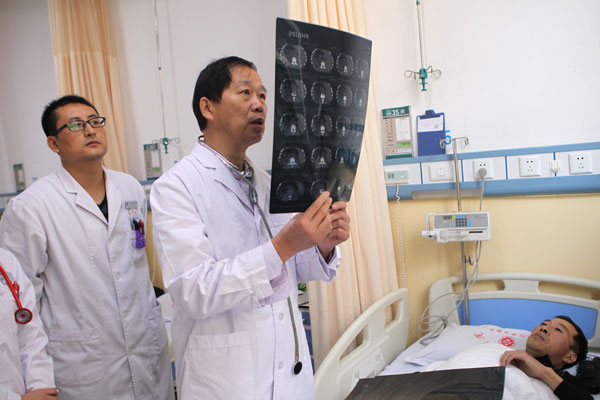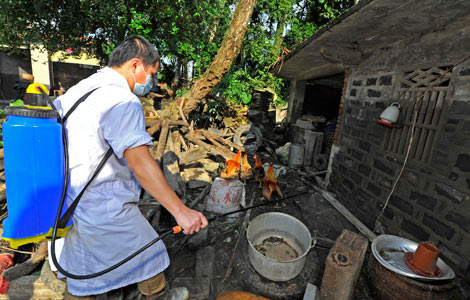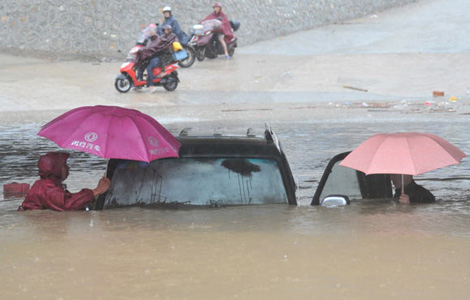When doctor meets micro blog
Updated: 2013-11-13 07:22
By Shan Juan (China Daily)
|
||||||||
Hypertension specialist reaches a big audience with educational information
On the walls of the inpatient wards of Beijing Anzhen Hospital, a large sign reads, "Please follow Yu Zhenqiu's micro blog for hypertension intervention".
Yu, the director of the hypertension department, said the micro blog helps him reach as many sufferers of high blood pressure as possible. Within his working hours, he can see no more than 30 patients even if he skips lunch.
 |
|
Yu Zhenqiu consults with a hypertension patient in a hospital in the Pinggu district of Beijing. Zou Hong / China Daily |
"I seldom drink water at work to save the time of going to the washroom," he said.
"For the great majority who cannot see top specialty doctors like me at the country's large key hospitals, micro blogs might offer help."
His frequent postings on high blood pressure prevention and intervention tips, and answers to frequently asked questions, have brought Yu about 70,000 followers on Sina Weibo, a popular micro-blogging website.
Apart from information on free-hypertension consultation sessions, he also replies to questions online.
"Many of my postings have been forwarded thousands of times, a result that could never be achieved by treating patients in the hospital," he said.
Writing posts is now a daily routine for him, such as washing his face and brushing his teeth, he said.
Yu, who is also deputy director of the China Hypertension Association, used traditional media first to share prevention and treatment tips and educational items about the disease, before moving online.
In 1995, he initiated a free hypertension consultation program, which lasted for more than a decade.
That was so well received by both the public and the hospital authority that he was able to set up a hypertension department in the hospital.
To sustain and expand his efforts, he began to write columns for a national newspaper on hypertension intervention and make regular appearances on a live call-in program on a local radio network.
At present he's working on a new book using previous Sina Weibo postings as a major source.
According to the National Health and Family Planning Commission, China is estimated to have more than 260 million hypertension sufferers on the mainland.
Only a quarter of those get diagnosed and treated. Worse, among those receiving medical intervention, only 25 percent receive proper treatment.
When current treatment guidelines are followed, blood pressure can be successfully controlled in up to 84 percent of cases, according to a new Chinese study that was presented at the recent European Society of Cardiology Congress 2013 in Amsterdam.
Despite this, a 2011 World Health Organization report estimated that more than 40 percent of Chinese sufferers of hypertension are unaware of their condition, about 50 percent receive no medication for the condition, and about 80 percent are not controlling it well.
For such chronic diseases as hypertension, health education is important for effective control in the long run, Yu said.
Yu expressed deep concern over the general standard of hypertension intervention in the country, and said treatment is not well regulated on the mainland.
More than 10 different clinical guidelines on hypertension diagnosis and treatment coexist, each of which were issued by different organizations.
In his clinical work, nearly all of the patents he sees have previously received inappropriate treatment at other medical facilities, he said.
Diagnosis and treatment of hypertension is complicated as the condition is closely associated with other underlying conditions such as diabetes and cardiovascular diseases.
Thus, measuring blood pressure is only the first step in treatment. Detecting the cause of hypertension requires a high level of expertise and clinical experience, he said.
He believes grassroots-level hospitals should serve as the foundation of hypertension intervention given the huge number of patients they see.
He is busy training such hospitals to enable them to shoulder that responsibility.
Almost every month, Yu is invited to give lectures and see patients at grassroots-level hospitals across the mainland.
Yang Xiuhua, a physician at the Xiangyang community healthcare center of Pinggu district, Beijing, said the center cooperates with the nearby Pinggu Hospital of Traditional Chinese Medicine to treat patients suffering from chronic diseases, including hypertension.
Yu has instructed and trained doctors working in suburban districts, including Pinggu, since 2003.
For cases of hypertension caused by other diseases or health conditions, or other complicated hypertension cases, Yang and her colleagues transfer the patients to the TCM hospital for treatment.
The center takes only patients whose health conditions have stabilized and who have been discharged from the hospital. It provides them long-term planned treatment, Yang said.
Healthcare workers at the center also take training courses given by doctors on managing chronic diseases.
"Hospitals at county or district- level work as links between top-level hospitals and community healthcare centers by teaching grassroots healthcare workers what they have learned from experts at top-level hospitals," Yu said.
The center has set up health profiles for more than 400 people suffering from hypertension, but the workload to keep their medical records current is "very heavy" as only three doctors work in the center, Yang said.
"We need to record their every visit to our center, or call them on the phone or even visit them at home to monitor their health conditions," she said.
Yue Xiaoli, a doctor at Jinxiang Community Healthcare Center, which services more than 20,000 people, said the center has more than 2,000 patients suffering from hypertension, less then 60 percent of whom have current health profiles.
"There are four doctors and two nurses in our healthcare center. We often work late to update the medical records in their health profiles. The workload to cover all the hypertension patients in the community is too great," she said.
"We should issue guidelines, particularly for grassroots-level hospitals," she said.

 PANDA! set to debut in Las Vegas
PANDA! set to debut in Las Vegas
 Lest we repeat the horrors of the past
Lest we repeat the horrors of the past
 Haiyan toll rises in Guangxi, Hainan
Haiyan toll rises in Guangxi, Hainan
 US honors its veterans with ceremonies, parades
US honors its veterans with ceremonies, parades
 Carnival season kicks off in Cologne
Carnival season kicks off in Cologne
 Typhoon Haiyan claims 6 in S. China
Typhoon Haiyan claims 6 in S. China
 Iran to give UN inspectors more access to nuclear sites
Iran to give UN inspectors more access to nuclear sites
 In love with Yunnan
In love with Yunnan
Most Viewed
Editor's Picks

|

|

|

|

|

|
Today's Top News
Alaskan seafood stars in Singles' Day
Third Plenum speaks in broad but telling strokes
China and US should focus on the 'big picture'
Leadership charts path
State security organ on the way
China, EU 'to launch investment treaty talks'
Obama's Iran legacy at stake
Survey: Chinese workers just not engaged
US Weekly

|

|





